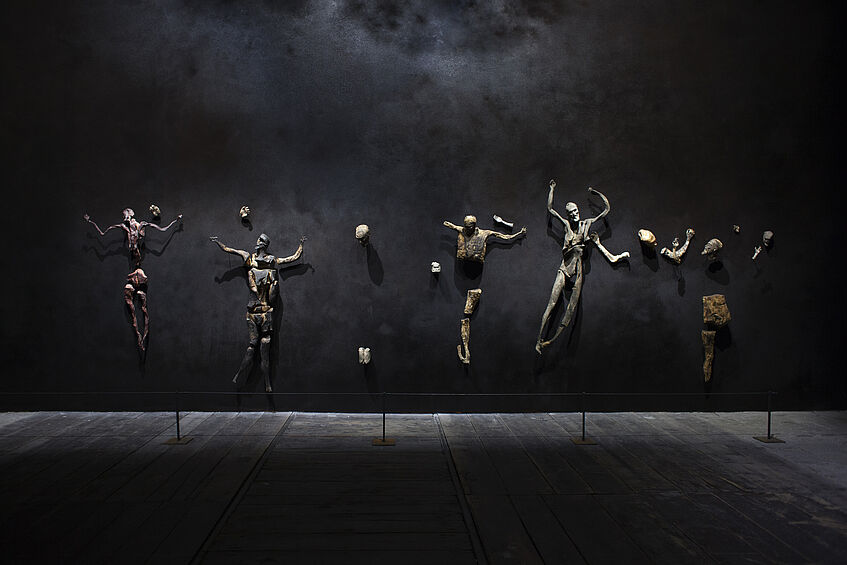From Vienna to Venice – scientifically investigating the effects of contemporary art in the first interdisciplinary CoBeNe workshop
In early November 2017 the first CoBeNe interdisciplinary scientific workshop took place, organized by PhD students for PhD students. Its goal was to foster the exchange of ideas, enabling participants to jointly develop and carry out a unique research project while getting to know fellow PhD students from different disciplines, all of this in an inspiring surrounding.
The workshop comprised a symposium which took place at the University of Vienna, and a subsequent excursion including a field study in Venice, Italy, at the 57th International Art Exhibition Biennale. While the symposium was partly open for the general interested public, the detailed planning of the study and the excursion and study itself were carried out by nine CoBeNe-PhD-students.
The research question tackled by the workshop was whether intentions of artists are actually recognized by viewers of their artworks: If an artist intends to display or elicit a certain kind of emotion with an artwork, can this emotion then somehow also be observed in the viewer? The workshop addressed this by using questionnaires, asking museum visitors about their experiences, and also via measurements of their physiological responses, such as skin conductance and heart rate.
The symposium took place on November 7th, 2017, and was held at the Faculty of Psychology of the University of Vienna. Its purpose was to get the participants prepared for conducting a field study and to provide them with basic relevant concepts and knowledge. Dr. Matthew Pelowski from the Department of Basic Psychological Research and Research Methods of the University of Vienna gave a presentation on “approaches to museum study of art”, giving an introduction to empirical aesthetic research in the field, detailing the advantages and pitfalls of conducting museum studies. Dr. Elisabetta Patron from the Department of General Psychology of the University of Padova gave a presentation on “how to measure psychophysiological correlates of emotional response”, introducing different psychophysiological measures that can be used to directly measure emotional reactions, and how to obtain them.
This initial input on basic scientific methods was followed by a lively discussion and a joint lunch of speakers and workshop participants. After lunch, Patrick Markey and Jane Boddy, CoBeNe students at the Faculty of Psychology and Department of Art History respectively, gave a brief and interactive presentation on the Italian Pavilion of the Biennale, as this had been chosen as the designated site where to conduct the field study. This was also the starting point for the second part of the symposium, with the workshop participants further discussing ideas and devising an actual study design to be carried out in Venice.
At the end of the day the participating CoBeNe students not only received a lot of scientific input, but also managed to come up with a basic study plan, deciding which physiological measures to record and which questions to ask in the administered questionnaire. This meant that everyone was tired, since it had been a long day, but also excited and looking forward to the actual trip to Venice.
Two days later, on November 9th, 2017, the nine CoBeNe workshop participants met at Vienna main station in the dead of the night (at least that is what it felt like…) to board the 6:25 a.m. train to Venice. The time on the train that wasn’t spent with either catching up on much-needed sleep or digitally formatting the participant-questionnaire, was filled with having discussions about art, science, empirical studies in general, the perfect density of original Italian hot chocolate, and other related topics.
Upon arrival in Venice in the afternoon, the edited questionnaire forms were printed at a local tiny copy-shop, and accommodation facilities were sought out. That evening, and over the next couple of days in general, it turned out that Venice offers a perfect environment for having inspiring scientific discussions and reflecting on and further improving the carried out research. The implementation of the study itself went surprisingly well, as participant recruitment turned out to be much easier than expected. Visitors of the Italian Pavilion were delighted to participate, partly due to the fact that the artworks exhibited in the Italian Pavilion were not only highly emotionally engaging, but to a certain degree also polarizing, so that many people might have been motivated by feeling the need to communicate their thoughts about the art via participating.
After initial software problems, the mobile physiological sensors soon were ready to go and were easily attached to the participants. Every sensor unit could be strapped around the participant’s arm, and would then trace his or her orientation and movement in three-dimensional space, the skin conductance, and the blood oxygenation. Seven participants volunteered for the collection of physiological data, which gave the CoBeNe students the possibility to learn how to use such measures for experimental investigation in the field. This was an especially good opportunity for those students that normally wouldn’t use such measures in the area of their study. Furthermore, a total of 130 people participated in the surveys, generating a wealth of subjective data. These data will be jointly processed, analyzed and discussed by the workshop participants, in order to answer the underlying question whether artistic intentions are actually picked up by art viewers. The goal is to publish the results in a peer-reviewed research journal.
To conclude, the CoBeNe workshop experience clearly indicated that, in Vienna as in Venice, innovative scientific research conducted with interdisciplinary peers is a diversely stimulating, highly motivating, and overall quite enjoyable activity!
Patrick Markey

Photo by: Italo Rondinella
Courtesy: La Biennale di Venezia
